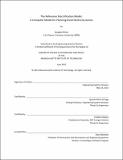The reference electrification model : a computer model for planning rural electricity access
Author(s)
Ellman, Douglas (Douglas Austin)
DownloadFull printable version (4.537Mb)
Alternative title
Computer model for planning rural electricity access
Other Contributors
Massachusetts Institute of Technology. Technology and Policy Program.
Advisor
Ignacio Pérez-Arriaga and Claudio Vergara.
Terms of use
Metadata
Show full item recordAbstract
Despite efforts from governments and other organizations, hundreds of millions of people-primarily in Africa and South Asia-still have no electricity service. Electrification efforts have historically been focused on extension of the main electric grid, but technology developments have made off-grid power systems, such as microgrids and home systems, viable alternatives for some areas. Especially since rural electrification typically depends on limited subsidies, if universal electrification is to be achieved in a timely manner, smart planning is essential to ensure that resources are directed towards cost-efficient technical solutions. Since the areas requiring electrification are expansive, the technology choices are many, and experience with off-grid systems is limited, planners struggle to evaluate tradeoffs between technology choices and estimate project costs. This thesis demonstrates that computer models that can automatically produce cost-efficient designs to the individual customer level can provide significant value to the planning process. The development of such a model by the author and collaborators at MIT and Comillas University, called the Reference Electrification Model (REM), is described. REM uses a series of heuristics to process input data, identify areas better suited for on-grid or off-grid electrification, and produce technical designs for recommended grid-extension and off-grid projects. In addition to the current state of REM, the rationale for model design choices and recommendations for future developments are described. The process and results of a pilot application of REM to Vaishali District, in Bihar, India are also described. REM will only be useful if it is actually incorporated into planning processes. In this spirit, concepts for how models like REM can benefit the regulation of rural electrification are presented, with a focus on India.
Description
Thesis: S.M. in Technology and Policy, Massachusetts Institute of Technology, Engineering Systems Division, 2015. This electronic version was submitted by the student author. The certified thesis is available in the Institute Archives and Special Collections. Cataloged from student-submitted PDF version of thesis. Includes bibliographical references (pages 106-109).
Date issued
2015Department
Massachusetts Institute of Technology. Engineering Systems DivisionPublisher
Massachusetts Institute of Technology
Keywords
Engineering Systems Division., Technology and Policy Program.